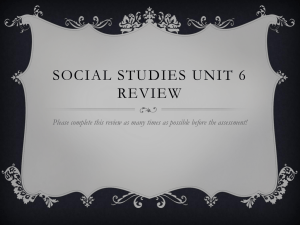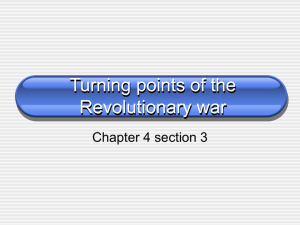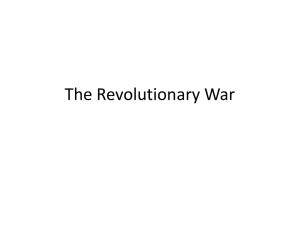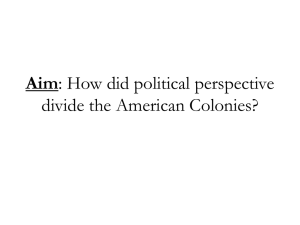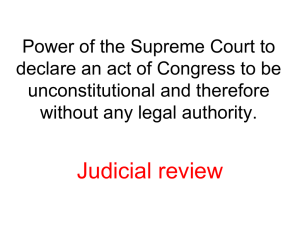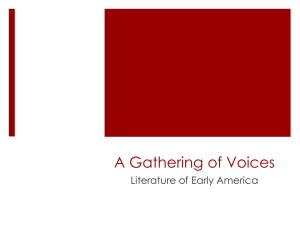Battle of Cowpens
advertisement
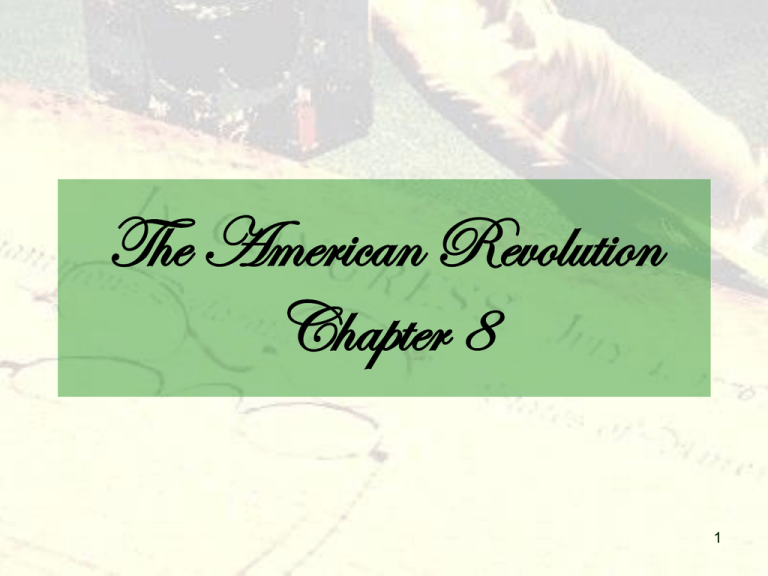
The American Revolution Chapter 8 1 •What did colonists want King George III to do? 2 Stirrings of a Revolution Angry Colonists •Angry over being taxed to pay for the French & Indian War •Complained that their rights as British citizens had been violated •Wanted King George III to recognize those rights •Some of the colonists started to think that freedom from Great Britain would be the best idea. King George III of England 3 Colonial opinion about freedom different… 4 Stirrings of a Revolution Colonists who were accused of treason could be locked in a pillory for everyone to see. American colonists disagreed about what the colonies should do about Great Britain. •Some wanted to become independent. •Those faithful to the king thought that talk about becoming independent was treason. 5 Who had the political power in South Carolina? What was the name of the new government created by the General Committee of 99? 6 Stirrings of a Revolution South Carolina oThe people with the most political power were wealthy Low Country landowners. o Many were Patriots who thought they needed to be free from Great Britain. oBy 1774, Patriots were getting tired of Great Britain oSouth Carolina’s General Committee of 99 created a new governing body for South Carolina called the Provincial Congress. 7 Stirrings of a Revolution In 1776: The Provincial Congress adopted South Carolina’s first constitution Would serve as the foundation of the government until the disagreements with Great Britain could be resolved Adopted before the Declaration of Independence was signed 8 Define bicameral What three things did the 1776 South Carolina Constitution establish? 9 Stirrings of a Revolution The constitution created a bicameral legislation (one that has two houses): 1. A lower house legislature of representatives that were elected by the people of the colony 2. An upper house legislature that was elected by the representatives of the lower house 3. A president of the colony, elected by the upper house, who could veto laws 10 What did the Low Country patriots do in the 1776 constitution to make sure that they kept the political power? 11 Stirrings of a Revolution The problems that existed between Low Country colonists and Up Country colonists could be seen in South Carolina’s first constitution. •The Low Country wanted to keep the power in the hands of the patriots and the elite (rich) •Wrote the constitution so the Low Country would have more representation in the legislature. Middleton Plantation, Charleston, SC 12 Stirrings of a Revolution At the 1st Continental Congress (1774) South Carolina representatives were Low Country elite and they served important roles • John Rutledge helped to draft a letter to the British people explaining the colonial position •Thomas Lynch and Christopher Gadsden designed an agreement stating the colonists would not buy or sell British goods. John Rutledge 13 Stirrings of a Revolution The American fighting forces were broken into three main categories: The Continental Army (the official army) The Militia (volunteer soldiers) The Partisans (guerilla warfare fighters) 14 Stirrings of a Revolution Militia men were volunteers, they were not professional soldiers. They used their own guns and usually did not have uniforms. Before the 1st Continental Congress ended: Plans were made to increase the colonial militias in case Great Britain declared war. In South Carolina: The Provincial Congress began preparations for a stronger militia. 15 Stirrings of a Revolution The plan for a stronger militia was a good idea. Britain found out that colonists were stock piling weapons in the towns of Concord and Lexington, Massachusetts The British’s attempt at taking the gunpowder left several colonists dead, and the rest of the colonists angry. Known as the battles of … Lexington & Concord 16 What group met after the battles of Lexington and Concord? How did South Carolina originally feel about fighting for independence? 17 Stirrings of a Revolution The 2nd Continental Congress met in Philadelphia after the battles of Lexington & Concord •The colonists had to discuss the topic of independence •At 1st, all of the colonies had concerns about voting for independence “Founding Fathers” by John Buxton South Carolina voted against fighting for independence. 18 Stirrings of a Revolution When a second vote was taken, SC voted yes, along with 11 other colonies • New York, the only colony to have more loyalists, than SC, did not vote On July 4, 1776, the Declaration was signed, included were the signatures of SC delegates: Edward Rutledge, Thomas Lynch Jr., Thomas Heyward Jr., & Arthur Middleton The Declaration of Independence listed the complaints of the colonists against the British 19 How did the Declaration of Independence change the focus of the struggle between the colonies and Britain? 20 Stirrings of a Revolution Declaration of Independence Changed the focus of the struggle from a fight for equality to a fight for freedom Some South Carolinians felt that the temporary constitution needed to be replaced by a more permanent one 21 The three changes that the 1778 South Carolina Constitution made… 1 2 3 22 Stirrings of a Revolution John Rutledge was the first South Carolina “president” In 1778, a new constitution was adopted 1. It changed the “president” of the state to “governor” 2. The representation in legislature was to be more evenly distributed 3. The Church of England would no longer be the official, statesupported church of South Carolina 23 How did the large loyalist population in South Carolina create a problem for the state? 24 The War Begins After the Declaration of Independence was signed… Many South Carolinians signed up for the armies of both sides The only colony with more loyalists than South Carolina was New York This caused a civil war within the colony There were over 137 battles and skirmishes within South Carolina alone 25 Patriots Loyalists Neutrals Describe the attitudes towards freedom of the German immigrants in the Up Country 26 The War Begins The state was divided into 3 main groups: patriots, loyalists, and neutrals loyalist. Patriots were colonists who supported the Continental Congress and independence Most were from the Low Country and served in local militias Loyalists were loyal to the king Were mostly found in the Up Country Patriots nicknamed loyalists “Tories” 27 The War Begins Many people who lived in the Up Country were not true loyalists They didn’t care who was in charge, they wanted to live their life without anyone interfering These neutrals were typically German immigrants who had… no allegiance to the king or the principals of freedom and democracy 28 Why was British capture of Charles Town important (what did they want to do)? 29 The War Begins In June of 1776 Before the Declaration of Independence was signed The British decided to capture Charles Town and use it as a base to launch attacks into other colonies While the British were waiting for reinforcements, they decided to capture the unfinished fort on Sullivan’s Island 30 The British 3 part strategy to capture Sullivan’s Island 31 The War Begins British battle map of Sullivan’s Island 32 The War Begins The British had a three part strategy: 1. 3 ships would be stationed on the islands southwest side 2. 9 ships on the southeast side 3. British troops were to march over from Long Island and attack the fort Unfortunately, their strategy fell apart, completely 33 Describe what actually happened during the Battle of Sullivan’s Island. 34 The War Begins 1. The 3 British ships on the southwest got stuck in the mud and became easy targets for the Patriot guns. 2. The other 9 ships had to sail in deep water to keep from running aground Which meant they had to travel directly in front of American guns 3. The troops could not wade from Long Island to Sullivan’s Island because the water was too deep and their gunpowder would get wet. Even today, boats still get stuck in the mud, and the British were using much bigger boats! 35 The War Begins Palmettos are very spongy because of their fibrous trunks. The logs were fitted together and filled with sand to create the walls of the fort. The colonists were not expecting the unfinished fort to survive a British attack But to their surprise it did The fort was made of Palmetto logs which were spongy Cannon balls either bounced off, or became stuck Providing armor for the fort 36 Describe the symbols on the South Carolina flag and why they are there. 37 The War Begins South Carolina added the Palmetto tree to the flag of South Carolina in recognition of this important contribution The crescent on the flag is not a crescent moon Patriot uniform Crescent moon But a reproduction of the crescent worn on the hats of the soldiers known as a gorget. 38 Sgt. William Jasper at the Battle of Sullivan’s Island 39 The War Begins During the Battle of Fort Sullivan, the flag flying over the fort was hit by a cannon ball and fell outside the fort. Worried that men would lose their courage when they saw the flag fall… Sgt. William Jasper ran outside the fort, grabbed the flag, and tied it to a cannon swab and put it back up where everyone could see it. 40 The Three Phases of the Revolutionary War 41 3 Phases of the War 1. Most of the battles in the 1st phase happened in New England 2. After the British were defeated at Trenton and Saratoga, they decided to try again to capture Charles Town. 3. The 2nd phase of the war took place in the South – Charles Town wasn’t so lucky 42 The British capture of Charles Town 43 The Southern Campaigns The British siege (surrounded and cut off all of the supplies) Charles Town The Patriot troops, who were trapped on the peninsula, were forced to surrender After the harbor was blockaded and supply lines were cut off Map from 1711 showing the Charles Town Harbor 44 Why did the British want to recruit people who lived in America? What did the British hope that southern loyalists would do? 45 The Southern Campaign Because Great Britain was so far away, it was expensive to send ships and supplies to the colonies. To help save money, the British wanted to find people already in the colonies to help them fight After losing at Saratoga and Trenton, the British moved to South Carolina. They thought that South Carolina’s large number of loyalists & neutrals would help them control the state & win the war. 46 Why the British did not get the southern loyalist support that they wanted: 47 The Southern Campaign If the British had treated the colonists with respect, they might have gotten the colonial support they wanted. Instead, the British treated the colonists harshly, burning churches, looting or confiscating homes, and harassing and mistreating the colonists. The remnants of Old Sheldon Church still stand near Yemassee, SC. The church was burned in both the American Revolution and the America Civil War. 48 The Southern Campaign Banastre Tarleton Bloody Banastre Tarleton British colonel who earned a reputation for being merciless At the Battle of Waxhaws, Tarleton allowed his troops to murder surrendering Virginians After this event, he became known as Bloody Banastre Tarleton Instead of scaring the Americans into giving up their fight, he made them angry and many neutrals and some loyalists joined the patriot cause. 49 The British convinced the Native Americans to get involved in the Revolution because… 50 Contributions to the War Effort Native Americans The British were, able to convince Native Americans to join the war At first, the Native Americans avoided getting involved Helped after the British promised to return control of the west to the Native Americans Supporting the British, the Cherokee attacked colonists 51 What did the British promise to the slaves who would fight with the loyalists? 52 Contributions to the War Effort African Americans •The British promised freedom to slaves who fought against the patriots • Although most of them remained slaves in the South • The slaves did not get the freedom that they were expecting •Some were taken and sold back into slavery 53 African Americans and Slaves 54 Contributions to the War Effort African Americans Some slaves served in the Continental Army (PATRIOTS) At first, South Carolina was afraid of slave revolts and did not want to allow slaves to work in nonmilitary jobs like cooking, cleaning, tending horses 55 Contributions to the War Effort A need for more manpower Laws were changed to allow 1/3 of the militia to be made up of slaves, but… Slaves were not allowed to be soldiers Slave held non-military jobs like cooking, cleaning, tending horses Unlike Britain, South Carolina did not offer slaves their freedom in exchange for their military service 56 Roles of women during the war 57 Contributions to the War Effort Women Emily Geiger memorized a secret message and kept it out of the hands of British. Rebecca Motte sacrificed two of her houses to the Revolution. •Took active roles on both sides of the war •Women managed farms and plantations (the men were fighting) • Some served as messengers, nurses, and gave their houses and their fortunes to support the cause •In order to protect their reputation, women would NOT cook for camps full of soldiers 58 Partisans guerilla warfare tactics 59 Battle for the Back Country Many men enlisted in the Continental Army Some men joined small militia groups known as partisans Partisans were patriots who fought using guerilla warfare tactics “hit and run” ambushes, attacking the British and escaping before they could retaliate 60 Battle for the Back Country The 3 main partisan leaders 1. Thomas Sumter “the Gamecock” Andrew Pickens From the Back Country 2. Francis Marion “the Swamp Fox” Francis Marion From the Northeast corner of SC (near Myrtle Beach) 3. Andrew Pickens “the Wizard Owl” From the Up Country Thomas Sumter 61 Battle for the Back Country Thomas Sumter was so important to the war, Fort Sumter in the Charleston Harbor was named after him. Thomas Sumter started his career as a partisan leader when his house was burned by British soldiers. He responded by rallying back country men into a partisan fighting force. Sumter and his troops attacked British supply lines in the Upcountry, frustrating the British and giving hope to the Patriots. 62 Battle for the Back Country Francis Marion used similar methods on the British. Marion earned his nickname by disappearing into the swamps after attacks. Andrew Pickens earned his nickname from the Native Americans in the Upcountry. These limestone cliffs have caves that open from the top down into the river (the hole at the water line). Francis Marion and his troops would use these cliffs to “disappear” from the following British army. 63 The Battle of Camden 64 Battle for the Back Country The Battle of Camden A major defeat for the regular Continental Army This loss meant that British now controlled almost all of S. Carolina This could have been avoided if American General Gates had traveled slowly so troops could rest and get supplies. In addition to the troops being hungry and tired, the North Carolina militia men involved in this battle were not trained to deal with regular British forces. The Militia panicked and fled, leaving the Continental Army to be defeated. 65 The Battle of King’s Mountain 66 Battle for the Back Country King’s Mountain The turning point for the American Revolution in the South Loyalist forces were camped out on the mountain. Mountain men from North & South Carolina attacked the British troops from behind rocks and trees. The British lost a lot of men & tried to surrender, but were offered no quarter by Patriots in retaliation for British (especially Bloody Tarleton’s) actions toward the colonists. After this battle, the British started to retreat from the Up Country. 67 Battle for the Back Country Soon after the British defeat at King’s Mountain, the Continental Army and partisan groups cooperated at the Battle of Cowpens. Partisan groups had a reputation among the British troops of running away The American commander was counting on this reputation as he created the battle plan. 68 Battle of Cowpens Diagram of Cowpens battle events 69 70 The Battle of Cowpens How was the militia reaction at Cowpens similar to what they did at Camden? What did the British do after the Battle of Cowpens? 71 Battle of Cowpens The partisans, under the leadership of Andrew Pickens, led the attack They fired two volleys and then fled the field Tricking the British into thinking that the Americans were retreating. The partisans had lured the British into a trap The British were soundly defeated and pulled out of South Carolina heading to Virginia. The Battle of Cowpens was the beginning of the end of the British in America. 72 Henry Laurens 73 The End and the Beginning After leaving S. C., British troops were soon cornered in Yorktown, Virginia and forced to surrender. South Carolinian Henry Laurens, president of the Continental Congress, was on the committee that negotiated the Treaty of Paris which ended the American Revolution and opened the door for the new nation of America. 74

